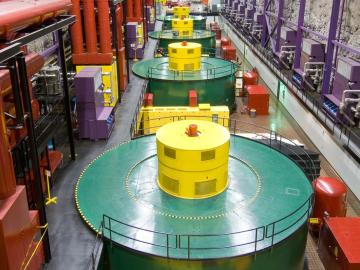Filter News
Area of Research
News Type
Date
News Topics
- 3-D Printing/Advanced Manufacturing (7)
- Advanced Reactors (2)
- Artificial Intelligence (16)
- Big Data (3)
- Bioenergy (5)
- Biology (7)
- Biomedical (3)
- Biotechnology (2)
- Buildings (8)
- Chemical Sciences (5)
- Clean Water (2)
- Climate Change (10)
- Composites (3)
- Computer Science (8)
- Critical Materials (1)
- Decarbonization (11)
- Education (1)
- Emergency (1)
- Energy Storage (5)
- Environment (10)
- Exascale Computing (4)
- Fossil Energy (2)
- Frontier (5)
- Fusion (3)
- Grid (4)
- High-Performance Computing (9)
- Isotopes (5)
- ITER (1)
- Machine Learning (6)
- Materials (9)
- Materials Science (10)
- Mathematics (1)
- Microscopy (2)
- Nanotechnology (1)
- National Security (7)
- Net Zero (3)
- Neutron Science (6)
- Nuclear Energy (5)
- Partnerships (7)
- Physics (1)
- Polymers (2)
- Quantum Computing (6)
- Quantum Science (10)
- Security (1)
- Simulation (10)
- Space Exploration (3)
- Summit (4)
- Sustainable Energy (11)
- Transportation (5)
Media Contacts

Scientists at ORNL and the University of Tennessee have developed an algorithm to predict electric grid stability using signals from pumped storage hydropower projects. The method provides critical situational awareness as the grid increasingly shifts to intermittent renewable power.

ORNL climate modeling expertise contributed to a project that assessed global emissions of ammonia from croplands now and in a warmer future, while also identifying solutions tuned to local growing conditions.

Scientists at ORNL are looking for a happy medium to enable the grid of the future, filling a gap between high and low voltages for power electronics technology that underpins the modern U.S. electric grid.

ORNL researchers have developed a novel way to encapsulate salt hydrate phase-change materials within polymer fibers through a coaxial pulling process. The discovery could lead to the widespread use of the low-carbon materials as a source of insulation for a building’s envelope.

ORNL and the University of Tennessee, Knoxville, co-hosted the 2023 National Society of Black Physicists Annual Conference with the theme "Frontiers in Physics: From Quantum to Materials to the Cosmos.” As part of the three-day conference held near UT, attendees took a 30-mile trip to the ORNL campus for facility tours, science talks and workshops.

Scientists at the Department of Energy’s Oak Ridge National Laboratory are using a new modeling framework in conjunction with data collected from marshes in the Mississippi Delta to improve predictions of climate-warming methane and nitrous oxide.

ORNL’s Janet Meier won the Energy Security category of the U.S. Department of Energy’s inaugural National Lab Research SLAM on Capitol Hill.

From July 15 to 26, 2024, the Department of Energy’s Oak Ridge National Laboratory will host the second U.S. Quantum Information Science, or QIS, Summer School.

Researchers at the Department of Energy’s Oak Ridge and Lawrence Berkeley National Laboratories are evolving graph neural networks to scale on the nation’s most powerful computational resources, a necessary step in tackling today’s data-centric

New computational framework speeds discovery of fungal metabolites, key to plant health and used in drug therapies and for other uses.




